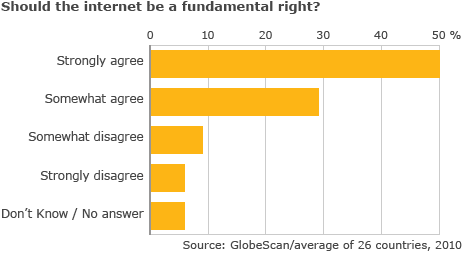Almost four in five people around the world believe that access to the internet is a fundamental right, a poll for the BBC World Service suggests.

The survey – of more than 27,000 adults across 26 countries – found strong support for net access on both sides of the digital divide.
Countries such as Finland and Estonia have already ruled that access is a human right for their citizens.
International bodies such as the UN are also pushing for universal net access.
“The right to communicate cannot be ignored,” Dr Hamadoun Toure, secretary-general of the International Telecommunication Union (ITU), told BBC News.
“The internet is the most powerful potential source of enlightenment ever created.”
He said that governments must “regard the internet as basic infrastructure – just like roads, waste and water”.
“We have entered the knowledge society and everyone must have access to participate.”
The survey, conducted by GlobeScan for the BBC, also revealed divisions on the question of government oversight of some aspects of the net.
Web users questioned in South Korea and Nigeria felt strongly that governments should never be involved in regulation of the internet. However, a majority of those in China and the many European countries disagreed.
In the UK, for example, 55% believed that there was a case for some government regulation of the internet.
Rural retreat
The finding comes as the UK government tries to push through its controversial Digital Economy Bill.
As well as promising to deliver universal broadband in the UK by 2012, the bill could also see a so-called “three strikes rule” become law.
This rule would give regulators new powers to disconnect or slow down the net connections of persistent illegal file-sharers. Other countries, such as France, are also considering similar laws.
Recently, the EU adopted an internet freedom provision, stating that any measures taken by member states that may affect citizen’s access to or use of the internet “must respect the fundamental rights and freedoms of citizens”.
In particular, it states that EU citizens are entitled to a “fair and impartial procedure” before any measures can be taken to limit their net access.
The EU is also committed to providing universal access to broadband. However, like many areas around the world the region is grappling with how to deliver high-speed net access to rural areas where the market is reluctant to go.
Analysts say that is a problem many countries will increasingly have to deal with as citizens demand access to the net.
The BBC survey found that 87% of internet users felt internet access should be the “fundamental right of all people”.
More than 70% of non-users felt that they should have access to the net.
Overall, almost 79% of those questioned said they either strongly agreed or somewhat agreed with the description of the internet as a fundamental right – whether they currently had access or not.
Free speech
Countries such as Mexico, Brazil and Turkey most strongly support the idea of net access as a right, the survey found.
More than 90% of those surveyed in Turkey, for example, stated that internet access is a fundamental right – more than those in any other European Country.
BBC






